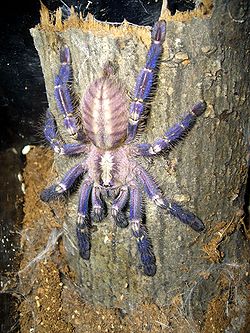- Poecilotheria metallica
-
Poecilotheria metallica Conservation status Scientific classification Kingdom: Animalia Phylum: Arthropoda Class: Arachnida Order: Araneae Suborder: Mygalomorphae Family: Theraphosidae Subfamily: Poecilotheriinae Genus: Poecilotheria Species: P. metallica Binomial name Poecilotheria metallica
Pocock, 1899P. metallica is a species of tarantula. It reflects brilliant metallic blue color. This whole genus of arboreal tarantulas exhibits an intricate fractal-like pattern on the abdomen. The spider's natural habitat is primarily Southeastern India and Sri Lanka. P. metallica was first discovered in a town in central southern India called Gooty. Hence, its common name is Gooty Sapphire Ornamental Tree Spider, or simply Gooty Sapphire.
Contents
Behavior
P. metallica's behavior parallels that of many arboreal spiders. In the wild the P. metallica live in holes of tall trees where they make asymmetric funnel webs. Their primary prey consists of various flying insects, which they catch manually (not in a web) and paralyze. It is not unknown for the spiders of this genus to live communally when territory, i.e. number of holes per tree, is limited.
This species is desired by many tarantula enthusiasts, with adults sometimes pricing above $500 in the USA. Demand for 2-week old unsexed spiderlings at US$200 is high, and there are examples of them being sold for much more. Prices can vary in other locations, particularly Europe. Like many spiders, the gender can influence price; females live for about 12 years, 3-4 times longer than males, making them more expensive. Also females are considered to be more useful for breeding, making demand higher. They are hardy, relatively fast growing spiders that are generally fed crickets, but can take on anything from a common fruit fly[citation needed] when spider-lings, to a new-born (pinky) mouse or anole when adults. They measure between 6-8" in legspan when fully grown. In captivity, humid environments with temperatures between 65° to 75°F with a humidity level of 75 to 85% are preferred.
Conservation
P. metallica is considered Critically Endangered by the IUCN Red List[1].
Bites
Although there has never been a recorded Human death from any tarantula bite, this species is considered to have a medically significant bite, with venom that may cause intense pain, judging from the experience of keepers bitten by other spiders from this genus[2][3][4][5]. They can move rapidly and may defend themselves when cornered, although they generally prefer flight to fight.
Popular Culture
- Markus Persson a.k.a Notch, creator of Minecraft, may have based the aggressive mob of Cave Spiders on this tarantula. The spiders in the game have blue skin, poisonous, but non-deadly bite, and a small size, similar to P. metallica.
Notes
- ^ Encyclopedia of Life
- ^ Gabriel,, R. (2002). "Notes and Observations Regarding the Bite of Poecilotheria pederseni". British Tarantula Society Journal 17 (2): 61–64. http://www.thebts.co.uk/Bite_ppederseni.htm.
- ^ Poecilotheria metallica - Arachnoboards
- ^ Phong's Tarantulas! - Tarantula bites
- ^ Schmidt, G. (1988): Wie gefährlich sind Vogelspinnenbisse ? Deutsches Ärzteblatt 85 Heft 28/29(2): 1424-1425. (u. a. Infos about Poecilotheria fasciata)
References
- Encyclopedia of Life: P. metallica
- Platnick, Norman I. (2009): The world spider catalog, version 10.0. American Museum of Natural History.
External links
Categories:- IUCN Red List critically endangered species
- Theraphosidae
- Spiders of Asia
Wikimedia Foundation. 2010.


